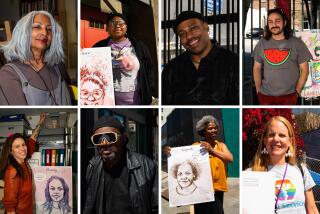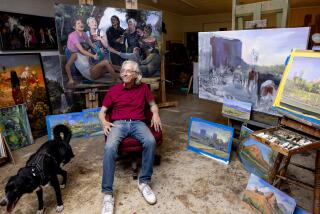Struggling Artists Find New Colony Downtown
For a decade, sculptor Kim Abeles suffered for her art, living one step ahead of the city building inspector in bootleg lofts above the gritty streets of downtown Los Angeles.
These days, Abeles, 35, still struggles with aesthetics. But no longer does she worry about the roof over her head.
Abeles and her painter husband, Russell Moore, share one of 45 units in Los Angeles’ first large-scale, city-subsidized housing for low-income artists, the Santa Fe Art Colony. Opened last December, the $3-million security-gated complex, housed on the one-time site of a terry cloth robe tailoring plant, is located amid warehouses and garment factories on the southeast perimeter of downtown.
“This is a nice change--to live in a space where I don’t have to hide all my clothes and do all my dishes in the shower,” said Abeles, who is two months pregnant. “This is a step up, and it’s very secure.”
Funded in part by a $1.2-million Community Redevelopment Agency loan, the Colony, at 2401 Santa Fe Ave., has quickly filled to capacity with eager young painters and sculptors whose material successes have yet to match their artistic visions.
Spaces ranging from 1,000 to 1,200 square feet in the main three-story brick building rent for $415 to $623 a month. That’s roughly 50% to 65% of the market rate for legal loft space downtown, where struggling artists are being increasingly squeezed out by lawyers, designers and other monied professionals.
Under the CRA’s financing arrangement, prospective tenants are required to have a maximum $18,000 yearly income to qualify for the cheaper units. They also had to convince the Colony’s developers that they are “serious” fine artists, who would use their units as work space as well as living quarters.
Consequently, none of the subsidized spaces have been rented to graphic or commercial artists or to people involved in photography, film or television production, according to general manager Leonard Skuro, himself a sculptor.
Also rejected was a man whose art form is floral arrangement.
“He was very serious about it and he did these huge things and you know he felt that he was an artist,” Skuro said. “I did not quibble with him that he’s an artist. My position was simply that we feel that he is in a commercially based art and his potential for making income is much greater than (for studio artists) where we targeted our support.”
Although some might argue that the Colony’s definition of “serious art” is arbitrary, Skuro said it is based on a principal aim of the development group, headed by arts patron Marvin Zeidler--to give fledgling artists an opportunity to pursue their creative impulses in a hassle-free environment.
“If one or two people out of the whole place become really good or make really good work, that’s all it is about,” Skuro said. “I mean what else can you expect?”
And if they reap financial rewards, they won’t be evicted for exceeding the income limits. “People aren’t penalized for getting successful,” Skuro explained. “They can just stay, and in a way, they’ll act as a role model for the other people in the studios trying to scrape by.”
“So far, we feel it’s been wonderful,” said Bill Jones, the CRA’s rehabilitation director. “The development partners seem to be benevolent to the artsy, folksy people . . . and (Zeidler) was (always) up-front. He said he wanted to make a little money but provide some spaces for low-income artists because they were getting chased out of places that were getting more trendy.”
Unfortunately, Jones added, the CRA, which has helped finance one other mixed-use art gallery, performance space and four-loft conversion project, has no funds for more art-related loans.
The Colony’s initial batch of tenants include a slew of abstract painters. There are also a handful like Abeles, who uses such functional items as toilet-tank parts, potato mashers and Rolodexes in her mixed-media, anti-establishment works, and Rudy Mercado, 25, who fashions historic battle-scene dioramas out of modeling clay.
Over the years, Abeles, a part-time college teacher, has shown her sculptures in galleries from Malibu to SoHo. Mercado has participated in exhibits in Barnsdall Park, downtown Los Angeles and Northridge.
Despite the Colony’s infancy, 14 of its tenants were among 75 downtown artists who participated this month in the annual open studio tour sponsored by the vanguard Los Angeles Contemporary Exhibitions.
“Some said you’re not going to get things done because of the social life, but people here are really serious about what they do,” painter Janet Jenkins said. “It’s not party animals.”
Indeed, when tenants are not painting or sculpting, many are busy fixing up their units.
As with most loft conversions, the only improvements the developer provided were full bathrooms. Ironically, in a building full of artists, the common hallways are still unpainted because of a $300,000 construction overrun, Skuro said. That has led to some tenants filling the second-floor corridor with their works and inspired one graffiti artist to scrawl, “Paint me ‘fore I die--Plato.”
Some tenants have already transformed their spaces into charming abodes with the feel of pricey apartments. Abeles, meanwhile, has traded artworks to a plumber in exchange for a rudimentary washer, dryer and kitchen sink. Still others, like roommates Tom Cobb and Mary Buck, live a Bohemian life style, cooking on a propane stove, taping their canvasses to the walls and boasting a floor with enough paint drippings to look like a Jackson Pollock original.
The latter couple’s table also stands out--as a sort of still life of rustic loft living. Among the items haphazardly scattered about one recent afternoon were a package of rice cakes, a bottle of soy sauce, several tubes of acrylic paint, a tape measure and a paint brush.
About 70% of the Colony’s residents hold part-time or full-time jobs to help supplement their meager art earnings, Skuro said.
For example, abstract painter Heidi Von Kann doubles as a part-time special-events manager for Union Bank. David Hines, who paints outdoor scenes, is a senior storekeeper at UCLA Medical Center. And painter/sculptor Mary Allan serves as a field service representative for the Long Beach Gas Department.
“I like it here (at the Colony) a lot,” Allan said. “It’s sort of an island within the industrial area. I like having other people who are like me around and not having that many other people around.”
Within blocks of the Colony are storage yards containing dozens of big-rig trucks owned by regional supermarket chains. But the project is so isolated that the nearest actual supermarket is two miles south in Huntington Park.
Tenants say that as time goes on, they hope to foster a supportive salon-type environment of creative interchange at the Colony.
“Like in the 1920s when Gertrude Stein was alive--I’d love to see something like that occur,” Abeles said. “At this point, it is not yet a big forum for art dialogue. . . . That would have to slowly evolve.”
More to Read
The biggest entertainment stories
Get our big stories about Hollywood, film, television, music, arts, culture and more right in your inbox as soon as they publish.
You may occasionally receive promotional content from the Los Angeles Times.










